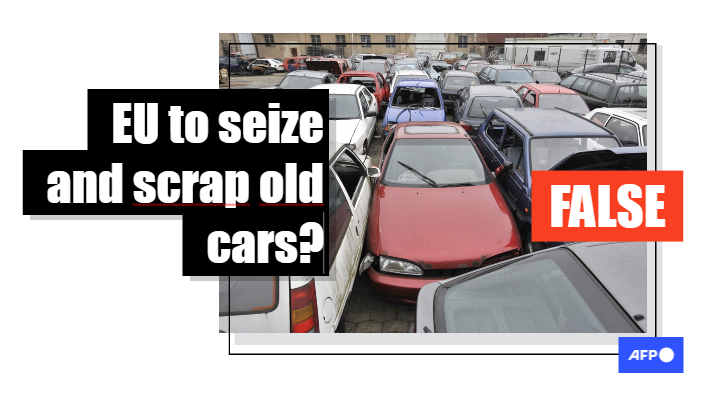“The EU is working on a new law to seize and scrap your car if it doesn’t meet their criteria. It’s all part of their climate agenda. The state will decide how long you will be allowed to own your car,” said a post on X and Telegram by Silvano Trotta, whose false claims have repeatedly been debunked by AFP’s fact-checking team.

The claim was first posted in English by @PeterSweden — real name Peter Imanuelsen — who describes himself as a Swedish “journalist” and “political commentator” and shares content that calls into question global warming.
The post was then picked up, among others, by the French blog Planetes 360, which frequently shares disinformation.
“The EU has something called the End-of-life vehicles directive, and they are looking to expand this to become so draconian that it recalls something that would have happened in the Communist Soviet Union,” the original post added.
Better recycling of end-of-life vehicles
In July 2023, the European Commission proposed revising the existing legislation on circularity requirements for vehicle design as well as on management of end-of-life vehicles.
Circularity, in the sense of the circular economy, consists of generating “goods and services in a sustainable manner by limiting the consumption and waste of resources and the production of waste,” the French government explained on its website.
With this proposal, the European Commission would like to introduce a single regulation to replace the 2005 directive on the reusability, recyclability and recoverability of motor vehicles and the 2000 directive on end-of-life vehicles.
A regulation is directly applicable in member states after its entry into force. Unlike a directive, it does not first need to be transposed into national law.
The goal of the revision is to improve “design and end-of-life management of cars” in order “to enhance the circularity of the automotive sector”, the Commission said in a July press release.
“The proposed actions are expected to generate 1.8 billion euros net revenue by 2035, with additional jobs created and enhanced revenue streams for the waste management and recycling industry,” it added.
However, the proposed regulation does not grant the EU the right to “seize and scrap your car if it doesn’t meet their criteria”, as the social media post claimed.
The regulation proposal is available to read here.
Its goal is to “provide a better framework for how we get rid of end-of-life vehicles in order to improve the way they are collected, treated and recycled,” Adalbert Jahnz, a European Commission spokesman, told AFP on November 29.
“But every owner remains the one to decide what he does with his vehicle. There is no talk of the EU being able to seize a vehicle and scrap it,” he said.
According to Emma Babin, an environmental attorney with the law firm Gossement Avocats, the proposed regulation mainly aims to enhance the “circularity” of the design and production of vehicles.
“The EU won’t be seizing anything. We’re talking about a text that lays down rules on including recycled material and on vehicle disassembly,” she told AFP on November 29. “The regulation would therefore mainly impose obligations on the manufacturers, the vehicle treatment facilities and the member states. Not so much on vehicle owners. That isn’t the goal,” she added.

The proposed regulation would notably require:
-that every vehicle be constructed so that it is reusable or recyclable to a minimum of 85 percent by mass (Article 4)
-that the authorised treatment facilities shall depollute the vehicles (Article 29)
-that the member states take necessary incentives to promote the reuse, remanufacturing and refurbishment of parts and components (Article 33)
The sole obligations for vehicle owners are listed in Article 26.

The requirement for owners of end-of-life vehicles to deliver their vehicles to authorised treatment facilities only had already been defined in the above-mentioned 2000 directive on end-of-life vehicles.
What is an end-of-life vehicle?
Article 3 defines an end-of-life vehicle as a “vehicle which is waste as defined in Article 3, point (1), of Directive 2008/98/EC, or vehicles that are irreparable according to criteria Part A, points 1 and 2 of Annex I.”
Here is the list of criteria proposed by the European Commission to determine whether a vehicle is an end-of-life vehicle. It notably falls under the definition if it has been “cut into pieces or stripped”, “welded up” or “completely burnt”.

taken on November 30, 2023

taken on November 30, 2023
The social media post claimed that the EU will establish a new set of criteria “that will decide whether you will be allowed to keep your car. If your car does not meet the criteria, the EU will seize your car and scrap it.”
But Jahnz said this is not true: “no criteria will be established to ‘decide whether you will be allowed to keep your car’. It will be up to the owner of the vehicle to decide whether he wants to get rid of it.”
Forbidden exports
He said the criteria listed above would be consulted primarily in the event of a resale to “determine whether it is a used vehicle or an end-of-life vehicle”. In the case of the latter, “the scraps must be handled responsibly instead of polluting the environment and wasting valuable resources”.
In fact, the second goal of the proposed regulation is to tackle the issue of illicit exports of non-roadworthy vehicles under the guise of used vehicles.
In the proposed regulation, the European Commission explains that “an important share of ‘missing vehicles’ subject to the ELV Directive are not collected to be treated under proper environmental conditions and a large volume of non-roadworthy and polluting used vehicles are exported from the EU every year”.
In 2017, 3.8 million end-of-life vehicles were found to be of “unknown whereabouts”, according to a European Commission report.
“The point of the criteria list is to assist the competent authorities in detecting potential wrongdoing in the form of attempts to sell end-of-life vehicles as used vehicles in order to circumvent waste management rules,” Jahnz said.
The list of controls and requirements on the export of used vehicles is laid out in Article 38.
According to the Commission, the proposed actions “will contribute to better road safety in third countries by preventing the export of non-roadworthy vehicles and reducing harmful pollution and health risks in countries importing used vehicles from the EU.”

Circularity passport
The social media post also claimed that the EU wanted to “introduce a ‘circular passport’ for vehicles. In other words, a passport for your car.”
While a circularity passport has indeed been proposed, it is in no way a “travel document providing or refusing permission to drive within the EU,” Jahnz said.
“This is a circularity passport, in reference to the circular economy. The goal being to ensure that the vehicle’s raw materials circulate: that we reuse them and do a better job at recycling them,” he added.
Described in Article 13, the circularity vehicle passport will be “a digital tool used to improve the provision of information on the safe removal and replacement of vehicle parts and components in a manner that is consistent with other digital information tools and platforms that already exist or are in further development in the automotive sector”.
“It’s just one more document tied to the vehicle, and it’s mostly meant for the treatment facility that will take charge of the vehicle,” Babin said.
According to Article 13, the circularity passport of a vehicle that has become an end-of-life vehicle “shall cease to exist at the earliest six months after the certificate of destruction for that end-of-life vehicle was issued”.
Finally, the social media post also claimed that “if the cost of repairing your car exceeds the value of your car, then the EU will seize it and scrap it for you”. It also alleged that “if your car has missed its regular EU checkup for two years, then it is considered to be ‘waste’ and they will scrap it”.
However, there is no mention of either claim in the proposed regulation.
“These claims are completely false and are not based on anything in the proposal,” Jahnz said.
In France, a vehicle must be destroyed if considered to be a wreck, according to Cartegriseminute, a French site with car information.
“This is the case when it has been subject to an accident, and after assessment, it has been judged to be technically or economically beyond repair or even a hazard,” it said.
European legislative process
The proposal is for the moment just a draft regulation.
“The proposal was made by the European Commission. It’s now up to the Parliament and the Council to debate, amend and adopt the text,” said Jahnz.

At the Parliament, the text must be adopted by a majority of voters while in the case of the Council it is qualified majority voting.
As explained on “Toute l’Europe” (All of Europe), an information site on the European Union, two conditions must be met for there to be a qualified majority: fifty-five percent of member states — or 15 out of 27 — must vote in favour and the proposal must be supported by member states representing at least 65 percent of the total EU population.
The entire legislative process takes time, which means it could be a matter of months or even years before the proposed regulation is adopted.
consacrés aux enjeux de l’énergie, du climat et de la biodiversité ici.
Chloé RABS
AFP France
Translation : Anna Maria JAKUBEK

- Home
- About AFP
- How we work
- Editorial & Ethical standards
- Fact-Checking Stylebook
- Meet the team
- Training
- Subscribe
- Contact
- Corrections
Copyright © AFP 2017-2023. All rights reserved. Users can access and consult this website and use the share features available for personal, private, and non-commercial purposes. Any other use, in particular any reproduction, communication to the public or distribution of the content of this website, in whole or in part, for any other purpose and/or by any other means, without a specific licence agreement signed with AFP, is strictly prohibited. The subject matter depicted or included via links within the Fact Checking content is provided to the extent necessary for correct understanding of the verification of the information concerned. AFP has not obtained any rights from the authors or copyright owners of this third party content and shall incur no liability in this regard. AFP and its logo are registered trademarks.
